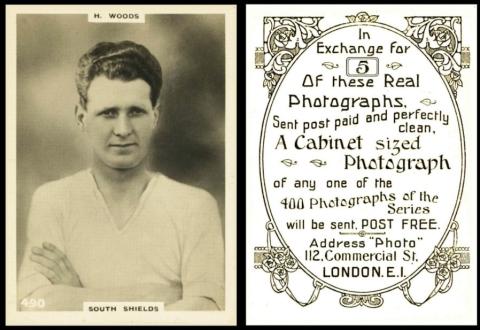
Here we have H. Woods, which ought to have suggested Henry Wood, or, more correctly, Sir Henry Joseph Wood, who conducted the Promenade Concerts for almost half a century, starting on the 10th of August 1895, and ending in 1944. He was so associated with them that after his death. later that year, they were officially renamed in his honour as the Henry Wood Promenade Concerts.
As for our man, Harry Woods, he was born in 1890 at St. Helens in Merseyside, and his first football team was the local one, St Helens Recreation. He trained as "a glass worker", which needs more investigation. He played for a couple more local sides and then, in 1911, was signed by Norwich City, where he played until the start of the First World War.
He must have had some mechanical experience as it is said he served in the Tank Corps; though he must have done something before that, as the first use of a tank was in September 1916 during the Battle of the Somme, and only then did the Tank Corps begin, as the Royal Tank Regiment which was, at first, joined in as part of the Machine Gun Corps. This suggests he may have started his career in an artillery unit, as it was primarily from those that the crews were selected.
When he was demobbed, and football had resumed, he moved to South Shields, which is the team he represents on this card. His first match for them was in August 1919. However, he did not stay there long, and in January 1922 he was bought by Newcastle United. This means that we can tie this card down to having been issued some time in 1921. He also did not settle at Newcastle, and joined Arsenal in August 1923. He fared better there, but was overshadowed a bit by younger, fitter, players - and in 1923 he was thirty-three years old. He then shifted to Luton Town, where his experience counted for more, but ended his career in 1930 with North Shields.
There is no record of what he did in the Second World War, all I have discovered is that he died in 1956, in his mid sixties.
This is the home page for the large sized "Pinnace" footballer photo cards. (You will find the home page for the smaller sets elsewhere, once I have written it).
Briefly "Pinnace" was a brand name, and it started including small photos of footballers, measuring about 45 x 35 m/m, in 1922, which could be exchanged for “a cabinet sized photograph" of players or teams. For a while it was thought that these larger cards may have been what that meant, but if you look at our card it is running the same offer, to swap five of these for a "cabinet sized photograph".
The larger, or “premium” cards are described in our original Godfrey Phillips reference book (RB.13, published in 1949), as :
- 81.B. Large Cards, size 83 x 59 m/m. Number issued unknown.
1. "Oval" design back, in black
2. "Single lined oblong" back, address "PINNACE" PHOTOS, in black. Fronts : -
(a) Player`s name at head, team at base
(b) Player`s name at base, no name of team, Some cards have printed slips surcharged on back with name of team.
(c) Player`s name and team at base
By the time of our World Tobacco Issues Index, this has been altered, to :
- FOOTBALLERS (A). Lg. Selected numbers only issued. ...P50-46
1. Back style 1, in black
2. Back with "Double-lined Oblong", address "PHOTO" or "PINNACE" PHOTOS.
3. Back with "Single-lined Oblong"
In the updated version of this volume, there is some additional information, namely :
- FOOTBALLERS (A). Skipped numbers in most printings. ... P521-290.
B. Large Size. All believed to be skipped numbers.
1. Back 1 - "Oval" design, in black.(?514)
2. Back with "Double-lined Oblong", address "PHOTO". (?852)
3. Back with "Double-lined Oblong", address "PINNACE" PHOTOS. (?2461). Some with player`s name only at base, or player`s name and team reversed.
Not sure what happened to the "Single-Lined Oblong" in this volume? Any ideas..?
